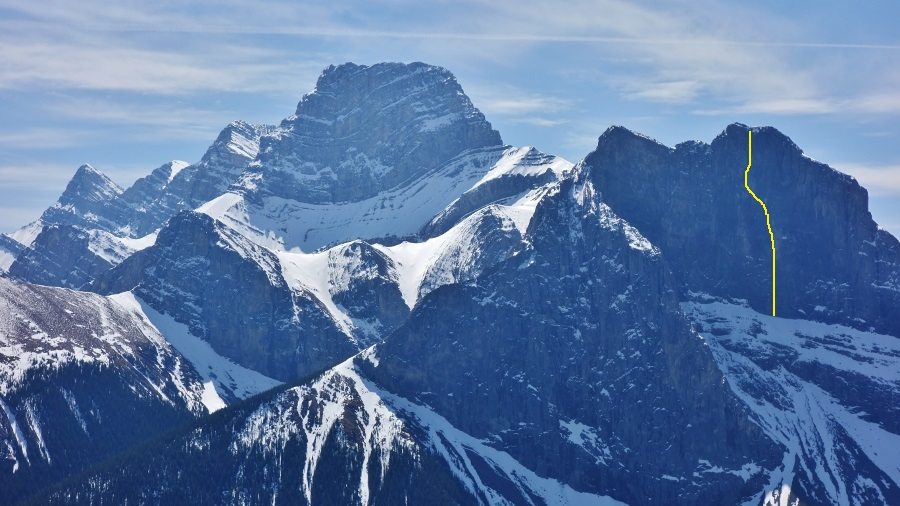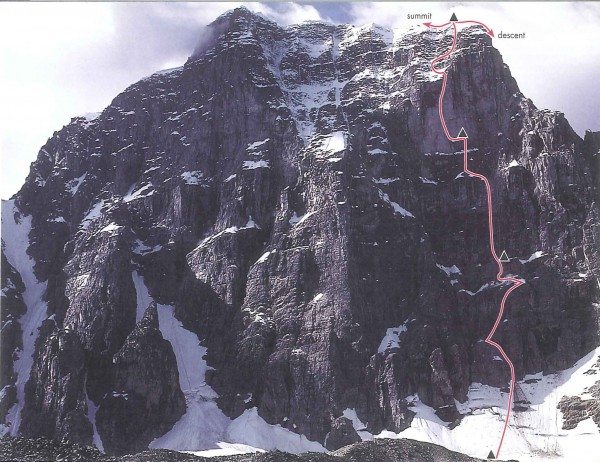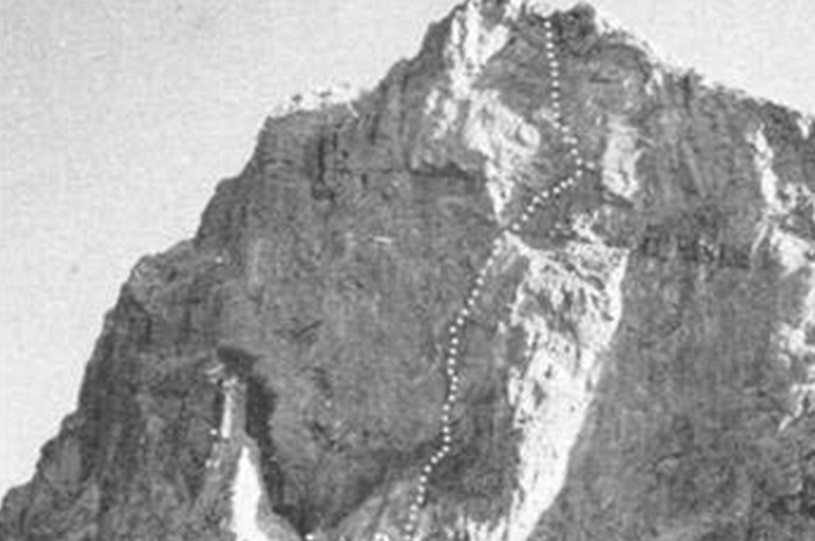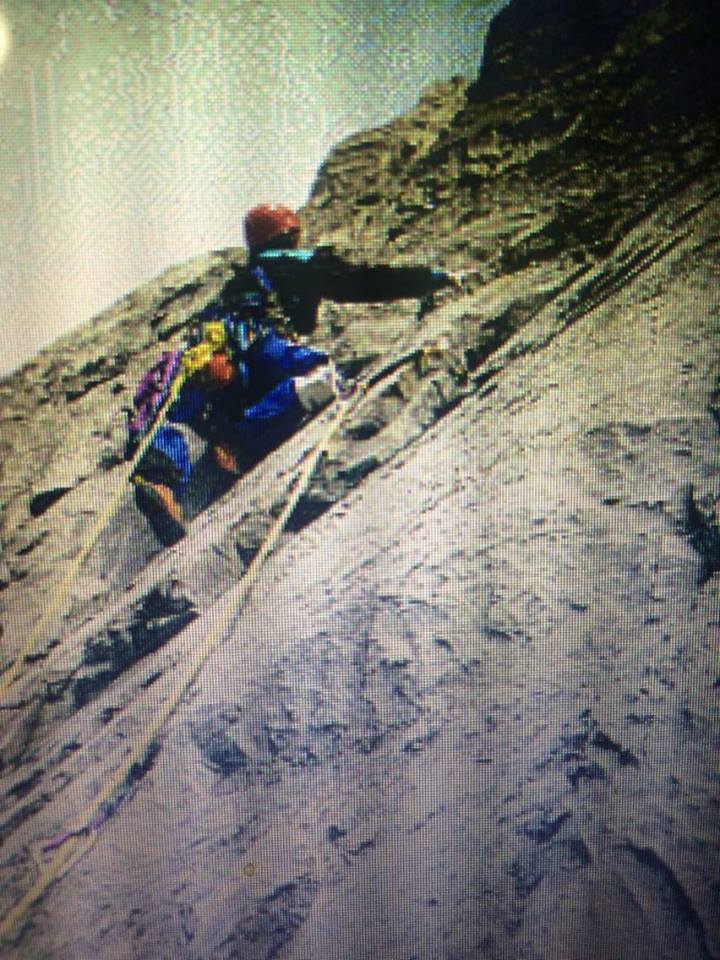Five Big Unrepeated Canadian Rockies Aid Routes
Big rock walls in the Rockies that are rarely tried and haven't had second ascents

Aid climbing in the Rockies is not like aid climbing in Squamish or Yosemite. Inching up limestone walls requires different skills than inching up granite ones. Some of the following routes are over 20 years old and still have never been repeated, or at least no one has recorded a repeat.

While there are still big alpine climbs that require aid, these five can be considered rock routes where the climbers don’t need crampons or ice tools and no glaciers are crossed.
Few topos exist by the first ascent teams, only vague descriptions of when and where to break out the aid climbing skills. All of the following routes also require strong free-climbing abilities, often on loose and run-out stone.
Iron Butterfly
This route is a 450-metre 5.11 A4 up the north face of the Windtower near Canmore. It was first climbed in 1988 by Jeff Marshall and Steve DeMaio. Despite a few top climbers like Raphael Slawinski attempting to repeat it, no one has reached the top. There are a few reasons why.
First, Marshall and DeMaio, who were famous for taking the hangers off their self-drive bolts, took the hangers off their Iron Butterfly bolts. This means if you head up, you will need to replace all of the hardware. Second, the route has run-out sections of A4 hooks. Rumours have it that DeMaio took a big whipper, the sky hook that caught his fall saved his life. Last, while many old routes with short aid sections have been freed, Iron Butterfly is mostly aid climbing.
It took them many days over a number of years to get up the wall, which Marshall first noticed on a school trip to West Wind Pass decades before. Even with fixed ropes in place, the final ascent took three days. It is the only grade VI climb in the Bow Valley. The pitches go 5.11, 5.9, 5.10 A3, 5.11 A3, 5.10 A3, 5.10 A4, 5.10 A2, 5.10 A4, 5.10 A2, 5.9 A1, 5.5 and 5.9. Marshall and DeMaio did not bring cameras on the final ascent because they were against publicity, but had taken a few photos on previous attempts. Below is DeMaio on pitch five on a steep roof.

Honky Tonquin
This is the biggest quartzite aid climb in the Rockies and only has one ascent. The grade VI+ 5.10 A3 is a 35-pitch monster route took the late Seth Shaw and Scott Simper many days to get up in July 1995.
The north face of Mount Geikie can be divided into four sections: nine pitches of 5.8ish climbing, 13 pitches of vertical through roofs, six pitches of wildly overhanging and seven pitches of moderate terrain. After reaching completing the first two sections of the wall in 1994, they bailed due to weather. In 1995, they spent five 16-hour days reaching their high point.
As the wall steepened, a waterfall poured past them and ledges were spaced in perfect belay spots up the 100-degree wall. “Picture a Yosemite-style ledge in a wilderness setting,” said Shaw. The steep rock was the most solid and they aided up a long crack system. On day six was a 30-metre pendulum into the waterfall. Shaw nailed the final A3 roof with nothing below him for 1,000 metres. It was the first new route on the wall in 19 years and it was the last.

Nine Nightmarish Nights on Nothing
This line probably doesn’t ring a bell for most climbers. The 650-metre grade VI 5.8 A4 was the first route up the north face of Gibraltar Mountain in the Misty Range in Kananaskis Country. The first ascent was by the late Billy Davidson and Jim White in July 1971 and took nine days.
Here is an excerpt from the story about the ascent by Davidson, “The weather was always bad. Snow, storms, lightning, rain, cold winds, belay from pits and jackets, and all this on a north face which got the sun only a couple of hours a day. Below us the route stood out in bold relief. What’s all that stuff about dropping something from the top and that’s the line to take.
“Forget that, just follow the droppings, that’s the line we took. I won’t bother with the usual trivia about how we nailed this, freed that, jammed this, squeezed that, bolted here, bolted there and generally screwed around everywhere. If you want to know what it’s like do the damn thing!”

Task Master
This is a 300-metre grade V 5.8 A3+ up the north face of Roche Miette near Jasper. It was put up in August of 1995 by Ken Wallator and Harvey Struss in a six-day push. They started in heavy rain and were determined to establish a line in any weather. By the end of the first day they were under heavy snow. “We were going up and we were going to have a great time and that’s just what we did,” said Stuff.
It begins at the far right side of the north face in an obvious corner that leads to intimidating roofs. After only four pitches, it gains the steep prow between the north and west faces. Struss and Wallator found a big ledge to bivi before two exposed pitches up thin cracks they nailed. “The first is a thin crack with hard nailing and a dicey hook move onto a RURP (A3) to a bolt belay on the left,” said Struss.
“The next pitch is also a beauty with a four-metre traverse to the right into an A1 corner to a big ledge with some good climbing at 5.8.” The only loose pitch on the route is the final one.

The Shining Path
It can be seen from downtown Canmore. It climbs an obvious corner on the Ship’s Prow wall southwest of town at grade 5.9 A2+. The often-looked-at 550-metre line was first climbed by the strong team of David Marra and Sean Elliot in the summer of 2001.
Like most of the rock on the south side of the Bow Valley, the rock ranges from poor to great and improves the higher you go. The team climbed it in one day with a big rack, lots of pitons and no bolts. It begins up the main corner, which had fixed pieces of gear from previous attempts and goes mostly at 5.9. At about halfway, the shattered rock gets steep and Elliot and Marra resorted to aid climbing up a number of pitches.
Past halfway a large flake of rock sticks out dangerously and the climbers moved out right around it and back into the corner. The feature breaks into more corners and cracks until a slab heads to the upper scree slope. Of all the routes on this list, the Shining Path is the only climbed in a day, so best to start with it.



